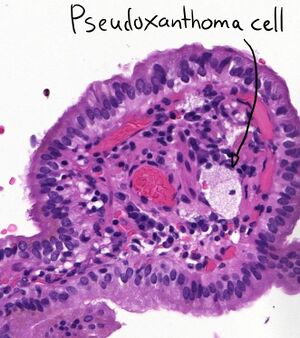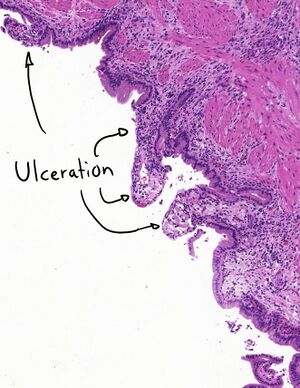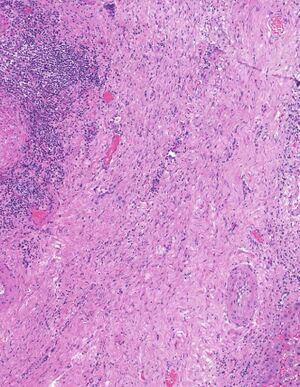28. Chronic cholecystitis: Difference between revisions
(Created page with "'''Staining:''' HE '''Organ''': Gallbladder '''Description''': We can see two pieces the gallbladder. The wall of the gallbladder is thickened. Some places you can see scar tissue formation. The mucosa is ulcerated at some places. There is leukocyte infiltration in many places. Some large cells close to the mucosa have a “foamy” morphology. '''Diagnosis''': Chronic cholecystitis. '''Causes''': * See theoretical topic 15 '''Theory''': The thickening of the wal...") |
No edit summary |
||
| Line 1: | Line 1: | ||
'''Staining:''' HE | [[File:Chronic cholecystitis overview.jpg|thumb|Overview of the slide]]'''Staining:''' HE | ||
'''Organ''': Gallbladder | '''Organ''': Gallbladder | ||
| Line 9: | Line 9: | ||
'''Diagnosis''': Chronic cholecystitis. | '''Diagnosis''': Chronic cholecystitis. | ||
'''Causes''' | '''Causes:''' See theoretical topic 15 | ||
'''Theory''': | '''Theory''': | ||
The thickening of the wall and the resulting fibrosis is characteristic for chronic cholecystitis. Ulceration of the mucosa is also common. | The thickening of the wall and the resulting fibrosis is characteristic for chronic cholecystitis. Ulceration of the mucosa is also common.[[File:Chronic cholecystitis immune cells.jpg|thumb|Plasma cells and lymphocytes]]Because this is a chronic inflammation and not an acute one will we not see any granulocytes, only macrophages and lymphocytes. | ||
Because this is a chronic inflammation and not an acute one will we not see any granulocytes, only macrophages and lymphocytes. | |||
The foamy cells are a type of macrophages called ''pseudoxanthoma cells''. They’re macrophages that have ingested cholesterol. | The foamy cells are a type of macrophages called ''pseudoxanthoma cells''. They’re macrophages that have ingested cholesterol. | ||
We can see a small part of the liver and liver capsule attached to the gallbladder as well. When there is a chronic inflammation of the gallbladder and due to the scar formation will it attach to the liver. Therefore, it is impossible to cut out the part of the gallbladder to make a slide without getting some liver on the slide as well. | We can see a small part of the liver and liver capsule attached to the gallbladder as well. When there is a chronic inflammation of the gallbladder and due to the scar formation will it attach to the liver. Therefore, it is impossible to cut out the part of the gallbladder to make a slide without getting some liver on the slide as well. | ||
[[File:Chronic cholecystitis pseudoxanthoma cell.jpg|thumb|Pseudoxanthoma cell|left]] | |||
[[File:Chronic cholecystitis ulceration.jpg|thumb|The discontinuity of the mucosa shows that ulcers have started to form]] | |||
[[File:Chronic cholecystitis pseudoxanthoma cell.jpg | [[File:Chronic cholecystitis fibrosis.jpg|thumb|Here we can see fibrosis and some lymphocyte aggregation in the upper left corner.|left]] | ||
[[File:Chronic cholecystitis ulceration.jpg | |||
[[File:Chronic cholecystitis fibrosis.jpg | |||
[[Category:Pathology 1 - Histopathology slides]] | [[Category:Pathology 1 - Histopathology slides]] | ||
Latest revision as of 12:00, 5 July 2024
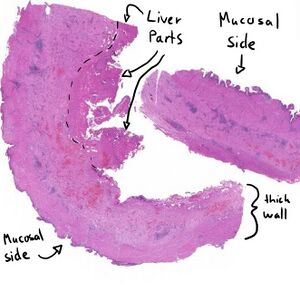
Staining: HE
Organ: Gallbladder
Description:
We can see two pieces the gallbladder. The wall of the gallbladder is thickened. Some places you can see scar tissue formation. The mucosa is ulcerated at some places. There is leukocyte infiltration in many places. Some large cells close to the mucosa have a “foamy” morphology.
Diagnosis: Chronic cholecystitis.
Causes: See theoretical topic 15
Theory:
The thickening of the wall and the resulting fibrosis is characteristic for chronic cholecystitis. Ulceration of the mucosa is also common.
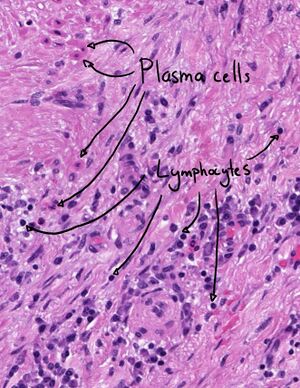
Because this is a chronic inflammation and not an acute one will we not see any granulocytes, only macrophages and lymphocytes.
The foamy cells are a type of macrophages called pseudoxanthoma cells. They’re macrophages that have ingested cholesterol.
We can see a small part of the liver and liver capsule attached to the gallbladder as well. When there is a chronic inflammation of the gallbladder and due to the scar formation will it attach to the liver. Therefore, it is impossible to cut out the part of the gallbladder to make a slide without getting some liver on the slide as well.
